#i got covid literally like three days before the new vaccine became available in my country :/
Explore tagged Tumblr posts
Text
so after a week of feeling like shit and experiencing some of the worst headaches i've ever had i just figured out i have completely lost my sense of smell too. do yourself a favor and go get your covid shot and your flu shot for the season if you can
#i got covid literally like three days before the new vaccine became available in my country :/#just getting out of the shower and putting my clothes on makes me out of breath#hopefully this time around i won't have to get blood thinner injections like the last time#covid sucks ass just because it's no longer as deadly as it used to be doesn't mean it can't still fuck you up#even if you're young and otherwise healthy#personal bullshit#covid
56 notes
·
View notes
Text
Traveling to Sweden by train
Things are slowly calming down again so I decided to spend a one week vacation in the Swedish city of Gothenburg. I want to share this journey with people as I promised friends to take lots of pictures anyway and because it personally means quite a lot to me to finally get out there again. Not only is this finally a proper vacation after a year and a half of sitting at home a lot with the coronavirus pandemic making it unfeasible to travel anywhere farther than where the S-Bahn could carry me. But this is also my first international journey in just over 10 years. Finally I feel comfortable taking on such a trek and because I am apparently a bit silly and like trains I decided to do this journey (nearly) all by train.
Planned route
Now how does one get from Berlin to Gothenburg by train? The route I will be taking starts in Berlin from which I will first board an ICE (InterCity Express; the German high speed train class of DB) to Hamburg to change to an IC (InterCity; a high-ish speed service) which is a joint operation by DB and the Danish national train service taking me all the way to the Danish capital of Copenhagen. From there I can take the Öresundtåg (literally Öresundtrain) over the Öresundbridge across the (can you guess it?) Öresund between Denmark and Sweden. The Öresundtåg stops in the city of Malmö, where I get a high speed train by the Swedish operator SJ that will get me to my destination.
This is quite a trip with a few changes and because I planned this with change times of at least 30 minutes in case there are delays the whole journey will take about 13 hours. The straight distance between the two cities is about 580 kilometres but due to the detour over Jutland the distance actually traveled is closer to 1000 kilometres.
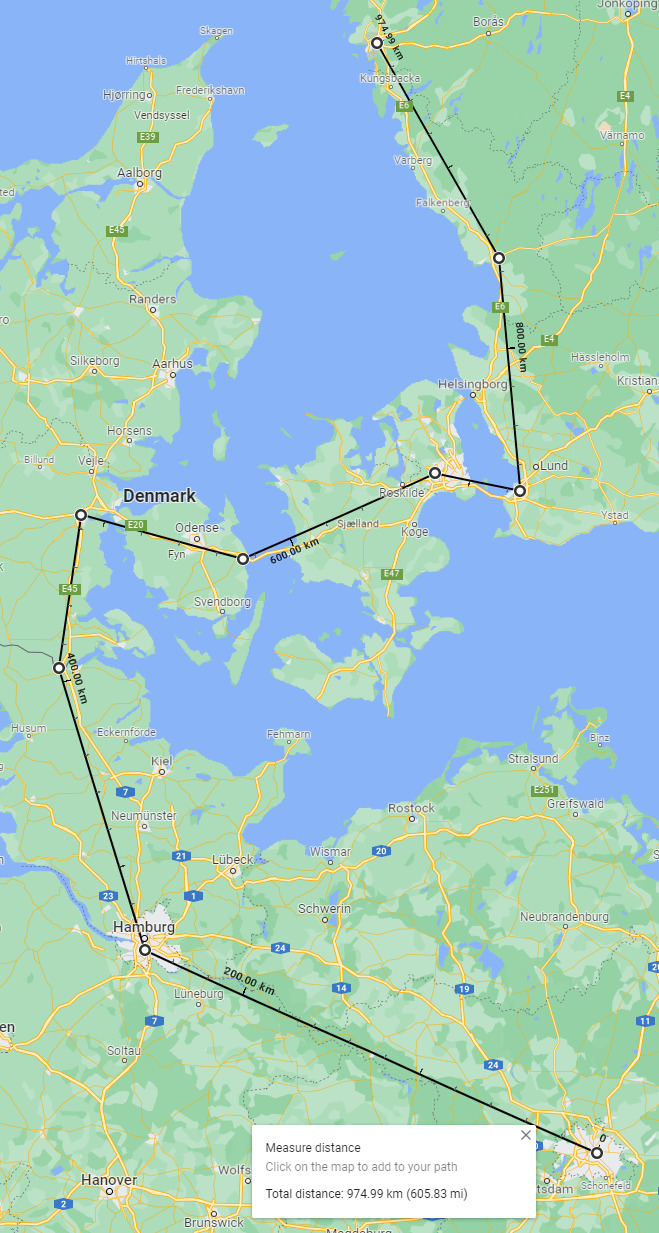
(the route vaguely traced in Google Maps)
I booked the tickets online a few weeks ahead and paid for all second class tickets about 70 € in total (and again about 70 € for the return trip). This was actually quite pleasant. The whole first part of the journey up to Malmö I was able to plan with the website of DB, which cooperates nicely with services of neighboring countries. The booking website of SJ was also easy to use, very user friendly and has a good English translation.
The paperwork
So because this is an international journey we have to consider paperwork of course. You can’t just travel to another country, surely there is a bunch of hoops you have to jump through, right? Well, because of the circumstances, kinda but not really.
First off: no visa required. I am a German citizen and am thus allowed to travel freely within the Schengen-area and the only required document is my ID card. And that is only in case I actually get carded. On train connections that is only done occasionally, but of course I will have my ID with me, so that will not be an issue.
Due to the ongoing Covid-19 pandemic it is also necessary to bring either a negative test result when crossing borders or a certificate of vaccination against the virus. Which I got. You can have it in paper or digitally and two weeks after your second shot you are free to travel again. No quarantining or anything. I got vaccinated anyway, so this was no issue at all.
Over all this got sorted pretty easily and I quickly had everything I need.
As a slight hint for anyone traveling to Sweden for the first time: paying in cash is incredibly uncommon especially in the cities there so I very much advise getting a credit card. I used a simple card I could charge with a bit of money, which I got from my bank with no additional cost and due to the limited money on it, losing it would not have been that bad as well.
Potential obstacles
But of course, stuff happened. Or rather, would maybe happen. I am writing this portion slightly ahead and at the end of reading this you will know, how it actually played out. As will I know, because by then I hopefully will have arrived.
Over the summer of 2021 the train drivers union GDL started talks with DB about raises and compensation over the additional hours drivers had done during the pandemic. Talks broke down though and thus they started striking.
There are more internal factors at play here as well but I am not in the know enough to properly judge or even explain the whole picture. But in the end it also does not really matter because I can’t really change it that quickly. So I have to live with the potential of the trains in Germany being canceled due to strikes. Only in Germany though. As soon as I reach Denmark I will be fine.
The strikes are not full time. They usually go on for two or three days and then normal service resumes within a few hours. And they tend to stick to work days. Which might mean I get lucky as I will depart on a Saturday. But I will watch the news closely and may have to rapidly come up with a backup plan.
Additionally and a bit hilariously I will have to switch onto a rail replacement bus on my journey to Gothenburg. Just on the weekend where I will travel they are doing some bridgework between Malmö and the town of Lund. This is certainly an inconvenience, but I just hope it will work out okay, as it is not that far to Lund. If this was not the case, I would have been able to make this journey exclusively with electric trains.
The strike
And of course it had to happen. On Monday the 30th of August the union announced a strike that would cover a whole week and with that, cover the weekend I wanted to travel on.
But no reason to panic yet. This gave me a few days to figure out how to navigate around this. By Tuesday afternoon DB had figured out which services would still be running.
I got pretty unlucky though. During this strike no DB service would run from Hamburg to Copenhagen. So it became necessary to find another way.
Thankfully I remembered the provider Snälltåget. They run a night train from Berlin all the way to Stockholm with stops in larger cities. Like for example Malmö.
And so for an additional price of just 10€ in total I got my DB ticket refunded, bought a ticket for the Snälltåget service from Saturday 7 in the evening to arrive on Sunday at around 8 in the morning and shifted the ticket I had bought with SJ to a train on Sunday.
Overall that was not nearly as bad as I initially feared and by Tuesday afternoon I had rescheduled.
The journey
Saturday came and in the evening it got time to head out. Due to the strike the S-Bahn service in Berlin was also pretty dodgy so I opted for a route with U-Bahn and bus. Which worked pretty well. The bus was a bit crowded but the whole trip was only a few minutes slower than any S-Bahn connection available to me.
Berlin central station is a very modern steel and glass construction that is very vertical with platforms going east-west above ground and platforms going north-south below ground. Due to the strike there were only few trains around but there were still some passengers taking the few trains in service.
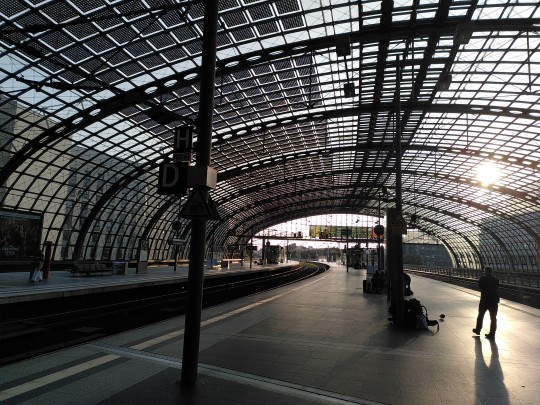
(a view along the upper platforms at Berlin central station with the low sun shining through the glass roof)
About 20 minutes before departure my train pulled onto the platform. Four carriages pulled by an electric loco. Very quickly I had found my seat and was happy to see us depart perfectly on time at 19:02. But then had to stop for twenty minutes just after leaving the city behind, because unauthorized people were on the track.
For this section with Snälltåget I had booked the most basic seat. Fortunately the person who boarded the train in Hamburg at around 22:00 seated next to me found another free seat, so neither of us had to be crammed in our seats and attempt to sleep.
Ah yes, sleep. As this was a night train a reasonable thing to do is to sleep. Unfortunately a few things got in the way of that. Firstly, the cabin light in the open saloon was never turned off. It was comparatively low, but still bright enough to disrupt sleep.
And then came the stop just behind the Danish border. In the small town Padborg, the loco that had hauled us all the way from Berlin got replaced by a Danish locomotive. This is due to a difference in voltage between the countries’ catenary equipment. That alone would have been fine, but unfortunately the Danish border guards deem it necessary to check every single train. And if that means disrupting 200 peoples sleep each night at 2 in the morning then they will do it. Which is what they did.

(empty platforms at Padborg, only some bright lamps break the darkness in the dead of night while the border guards board the train)

(the sun is just barely rising over the flat and still dark Danish countryside)
During the next few hours I managed to catch a bit of uneasy sleep until the early dawn. Because I realized, that we were nearing Copenhagen I decided to just stay awake and watch the landscape zip by as the sun crept up. And it was worth it.
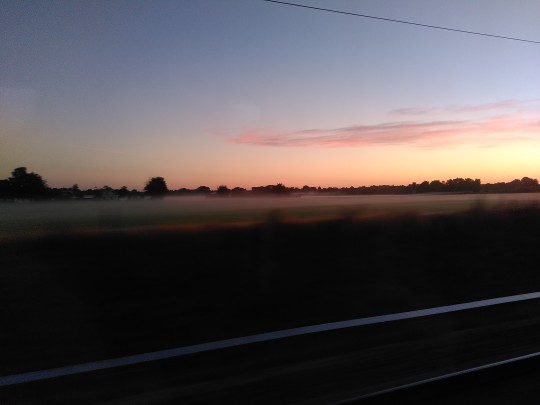
(banks of mist over fields)
Fields covered in mist like ghostly apparitions. And right as the sun really rose and made it easy to see, we crossed the Öresundbridge. A wonderful view.
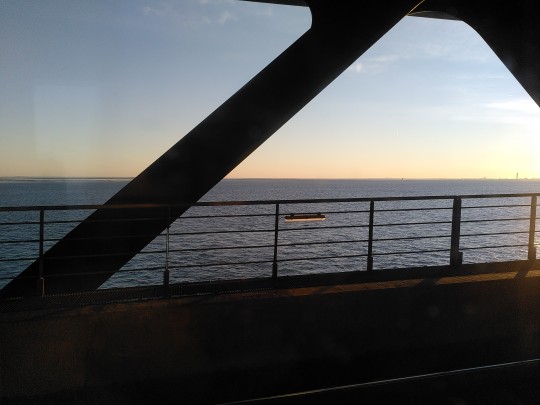
(the metal frame of the Öresundbridge with the sea visible in the background, the sun is shining just out of frame to the right)
After the bridge it was not far to the city of Malmö. Unfortunately we were delayed slightly again. Slowly I felt like fate was trying to keep me from reaching my destination.
But because I was cautious this delay was not enough to mess with my plans. The train arrived slightly delayed at around 08:30.
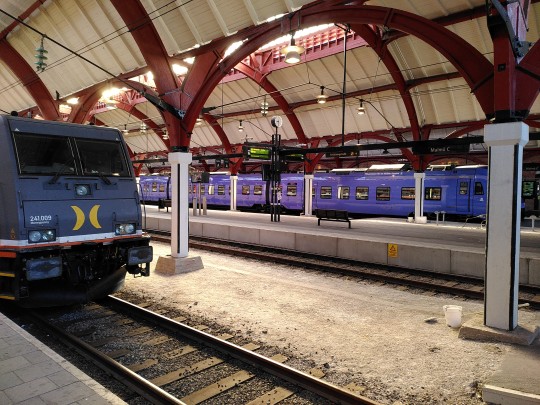
(the loco that had pulled me through the bit of Sweden I had crossed this far sitting at a platform in Malmö)
I did not take time to look at Malmö central station, but from what I saw it is a nice station with the older platforms being complemented by a modern building housing some shops. But I had a bus to catch, so I headed for one of the exits.
Some helpful staff was able to point me to the replacement bus I now had to take to get to Lund. The bus trip, while a bit inconvenient was actually a nice change. And I got dropped off right in front of the train station an hour before my train was due to depart.
And that last leg of the journey was very pleasant. The X55 even in second class was wonderful to ride. Good leg space, large windows, pleasant decor and a comfortable ride paired with sunny views of the Swedish countryside. This train made it immediately clear to me, that Swedish rail has a wider loading gauge than most other countries and the cars are built accordingly with lots of room. Zooming through hills and past fields at not very high speeds was just a delight.

(a bit of Swedish countryside with fields and farm buildings under a blue sky, in the distance one can just about see the coastline)
And after about 2 and a half hours my final train for that day pulled into Gothenburg central station. Which is a wonderful old station that has been maintained very well. The main concourse still has it’s original dark wood framing and large murals show different old railway lines all under an iron and glass ceiling, which makes it feel large but still cozy. Even tired as I was, I was surprised by how nice this station is.
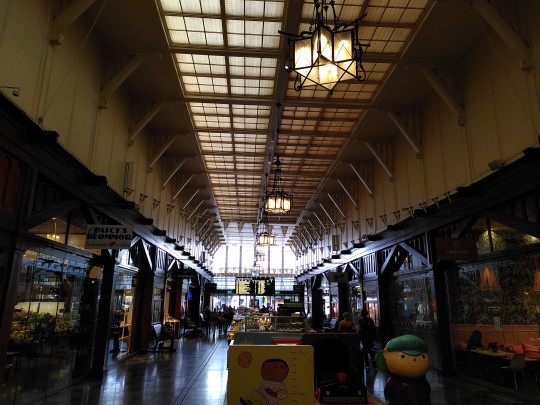
(the main concourse in Gothenburg central station)
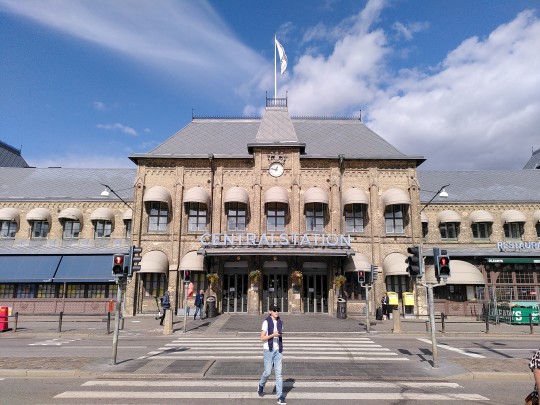
(the front of Gothenburg central station in broad daylight)
From the central station one can easily get anywhere in the city with the many trams or a bus which stop just a hundred meters from the station entrance.
In conclusion
This whole trip is now about two weeks in the past and I had some time to think about it. In general I still think this is a good way to get to Sweden, especially if you are on a budget. Next time I want to try out a proper cabin with a berth on the night train, because I am just too tall to sleep in any way comfortably in a seat.
4 notes
·
View notes
Text
Timing Is Everything
Fate here to provide a lesson from my therapist’s mouth to yours on the power of adapting to adverse conditions. Or maybe that was the biologist who appealed to me for help after claiming I was the cause of him being ostracized from his church, his colleagues, and his community…who can keep ‘em straight, amirite?
Fate,
I was literally born with a skewed sense of timing. Had I been born one day earlier, I would have been the oldest of the students in the grade below me, but as it was, I wound up being the youngest of the students in the grade I was in. Research suggests that surely being that far behind the bulk of my classmates, even if it was by a matter of weeks to months, was the reason I struggled so much with classwork, homework, and team sports.
I got chicken pox three months before the vaccine was available. I didn’t get symptoms until the very end of the last day of class fall semester, when my mom sent me to school because I faked sick so much she was sure I was doing it again, and then had to spend the entirety of Christmas break cooped up away from my family and friends with a fever and the constant itching, only to be just fine when school and all the struggles that came with it started up again.
The year I took the SATs was the year the College Board switched from the 1600 point system with no mandatory writing portion to the 2400 point system where essay writing, never my strongest subject, became a required part of the package. The local college I did manage to get into instituted strict caps on their financial aid packages that year. They also dropped the major I had wanted to get my degree in just as I was eligible to declare it (and had already gotten a good amount of the introductory classes out of the way).
I busted my ass to graduate a year early in spite of all this and did so…just as the Great Recession was declared and employers stopped hiring. I probably would’ve been okay, because my parents had been planning to move away, rent out part of their old house/my childhood home, and let me due landlord/property management duties, but the rental market dried up and I was forced to move back in with them with no resume-padding opportunities (and also living with my parents again, le sigh).
I’d gotten a degree in computer sciences, which should’ve led to all sorts of opportunities, but every tech firm or private development co. I joined would fold within months of me coming on board. I did manage to save up money which I’d invest, only to have whatever promising company I’d bought stock in collapse overnight due to being busted for fraudulent practices or whatnot.
I finally got a stable-sounding opportunity a couple years ago. I was set to start on March 16th, 2020. Two days before that, most of the US followed the example of most of the rest of the world and shut down in a mostly useless attempt to stop the COVID-19 pandemic in its tracks. My new company immediately switched to remote work for its existing employees, and for those like me who would have to be physically present in order to do our jobs (the role was in computer hardware rather than software), well, we were S.O.L. And speaking of the ‘rona, there’s another fun disease I caught just before the vaccine was made available. This time, I got it a week before I would have been eligible to get my first dose from the local pharmacy. For having an allegedly mild case, I sure do have an awful lot of trouble breathing when I walk across parking lots still, not to mention feeling slower and even shorter on attention than I used to be.
The big picture’s bad enough, but there’s also other, pettier stuff: trying to take Mom out to her favorite restaurant only to find that they’ve changed their schedule and we’re going there on the day they’re closed. Trying to take a date to see a movie only to find that the theater’s shut down to deal with an emergency flooding situation. Not having time to claim a Buy One, Get One Free coupon until the day after it expires.
My grandmother always used to tell me that “God chooses his toughest warriors to fight his greatest crusades,” but Fate, can’t you (or Him, or whoever) cut me a break once in a while?
Your God may indeed want strong warriors, but I believe He (or I, or whoever) also needs test dummies to see how the status quo compares to the new idea in order to verify whether “new” also means “improved.” Sometimes, He/I/Whoever will let our guinea pigs - er, subjects - flip from the control to the experimental group, and as with all experiments, the outcome is uncertain until we let the test run its course.
It’s not all the time that we have a favorite subject whose results provide constant amusement, of course.
0 notes
Text
Red State, Blue State, Twin Outbreak: Behind Wyoming and Colorado’s Anomalous Covid Spikes
WHEATLAND, Wyo. — Brandon Graves said covid-19 arrived in Wheatland the way new movies do in this High Plains farming town: months after hitting the big cities and without much fanfare.
“It kind of trickled in and it never really exploded here,” said Graves, a lifelong resident and mayor of the town of about 3,500, the largest in Platte County.
Many residents say the virus that causes covid has felt more like an inconvenience imposed on them by outsiders than a public threat. For instance, utility bills came late because the company that prints them is in a city that was hit hard by covid. And the town is stuck repairing and re-repairing one of its aging trash trucks because the ordered replacement has been delayed by more than a year because of a covid-induced shortage in microchips.
Then there’s the “Colorado Navy,” the locals’ nickname for the parade of vehicles with boats in tow that cross the state line each summer. Their numbers swelled last year as people searched for lakes and campgrounds open during the pandemic, said Shawna Reichert, executive director of the Platte County Chamber of Commerce.
Campers were packed so tightly around Grayrocks Reservoir, a popular fishing spot outside of town, Reichert said, “it literally looked like a city.” The crowds trashed the place, and a rancher lost several cows. Plastic bags were found in their stomachs.

It’s no surprise many residents are lukewarm to the idea of covid vaccines: As of July 6, about 29% of Platte County residents were fully vaccinated, according to the state health department. And Wyoming, a staunchly conservative state, had about 32% of residents fully vaccinated, giving it one of the lowest vaccination rates in the nation. Perhaps also not surprisingly, the state has one of the highest new case rates in the nation.
What might be surprising is that Wyoming’s neighbor to the south has recently experienced similar case spikes, too. Colorado is a Democratic-leaning state whose population is about 53% fully vaccinated, placing it in the top 15 states in vaccination rates. It also had the 12th-highest rate of new cases among states as of July 9, ranking a few states lower than Wyoming.
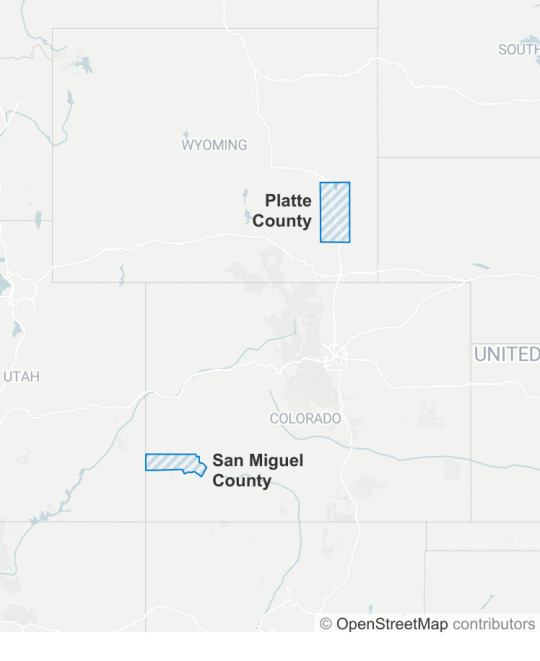
Within Colorado, one of the most vaccinated counties is San Miguel County, which, like Wyoming’s Platte County, has a population of a little over 8,000 people. Both counties entered June with high transmission rates and sustained them for several weeks straight, but their vaccination rates are inverses of each other: Fewer than a third of Platte County residents are fully vaccinated, while about a third of San Miguel County residents are not. The common thread in both places: pockets of unvaccinated residents.
Health officials are keeping a close eye on covid hot spots that have emerged in recent weeks tied to low vaccination rates.
“One of the things that we’ve been sounding the alarm about is the need for hyper-local data,” said Jennifer Nuzzo, an epidemiologist with the Johns Hopkins Bloomberg School of Public Health. “The state could look fine and you can think, like, ‘No big deal. We’ve got this.’ But then when you drill down at the county level, you could be seeing a much different story.”
The county level might not even be granular enough to show true risk. Small upticks in cases can be meaningful even in sparsely populated counties — and not just because of the potential for transmission to spill across county or state lines.
“Small rises in cases in rural areas can have devastating consequences because, chances are, there’s fewer health care resources in those places in order to save lives,” she said. “There’s been good studies that show that, partially, the ability of the virus to kill people depends on the bandwidth in the health system to save people.”
After months of reporting few cases, Platte County Public Health posted a warning on Facebook in early June that 14 people had tested positive for covid in the same number of days, and 12 ended up in the hospital.
That string of cases bumped Platte County into the “red zone” of high transmission rates. “Platte County contact tracing has shown that unvaccinated people are going to work and group gatherings while sick,” the post read.
Joan Ivaska, senior director of infection prevention for Banner Health, which runs a 25-bed hospital in Wheatland, confirmed that covid patients were admitted throughout June, though she declined to say how many. The hospital has only two adult intensive care beds.
She and other health officials continue to emphasize that better vaccine coverage is the only way to get back to normal.

The challenge, said Kim Deti, a spokesperson with the Wyoming health department, isn’t just the politicization of the covid vaccines, which has turned many against them, though that is a factor. It’s also that many people have resumed activities and believe the pandemic is behind them.
“We’ve had relatively low levels of covid-19 illnesses in most areas of the state for a while now, which affects threat perception,” Deti said. “There are many people working very hard and trying everything they can. Wyoming’s coverage rate is not for lack of effort.”
In San Miguel County, Colorado, people were fired up about getting shots from the outset. “Interest has been very, very impassioned since vaccines became widely available,” said county spokesperson Lindsey Mills.
San Miguel County hit President Joe Biden’s vaccination goal of getting at least one dose into 70% of adult residents weeks before July 4, the deadline the nation as a whole missed. Yet the county was experiencing a surge in covid cases similar to that of its Wyoming counterpart. More than 460 days after Colorado declared covid a disaster emergency, San Miguel County recorded its first covid death on June 14.
The reason? It turns out not everyone was as enthusiastic about the vaccines as San Miguel County’s high rates indicated. Numbers provided by the local health department show that on the county’s east side, home to the affluent ski resort community of Telluride, about 80% of eligible residents opted in. On the west side, what residents call the West End, only about half did. That left the county vulnerable to continued spread.
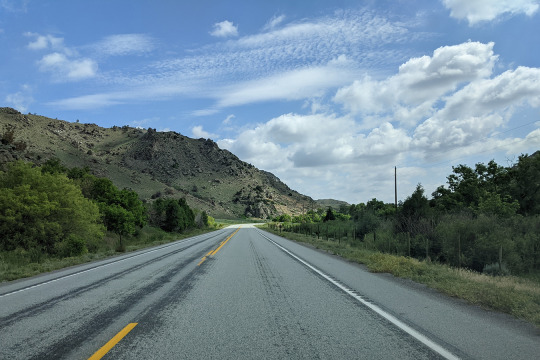
That east-west divide in San Miguel County reflects a preexisting cultural divide, according to Mike Bordogna, the county manager. The sparsely populated west side, which stretches to the Utah line, was historically the county breadbasket, growing crops and livestock that fed mining towns like Telluride, now known for skiing and its film and bluegrass festivals.
A KHN analysis of data provided by San Miguel County shows that, since the beginning of the pandemic, most of the county’s covid cases were on the east side, where most residents live. But in May, the tables turned. While the west side typically recorded less than 10% of the county’s cases over the first year of the pandemic, in May and June its share suddenly was more than 64%, aided by the arrival of the delta variant.
In late May, an unvaccinated woman in her late 70s living in the county’s West End caught the delta variant at a potluck following a funeral and died after a week in the hospital. Other unvaccinated funeral attendees caught the virus, too.
“Pretty much everybody that was there that was unvaccinated became sick after the fact — either tested positive or just became sick and didn’t test,” said Amanda Baltzley, contact tracing supervisor for San Miguel County Department of Public Health.
Sheila Grother, an EMT and contact tracer who works with Baltzley and has lived in the West End town of Norwood for more than 30 years, said she’s gotten nowhere trying to persuade people to get vaccinated — even though two vaccinated West End residents who contracted the delta variant around the same time as the woman who died, and were also over 70, recovered.
“I’ve been in people’s homes when they’re at their worst and I’ve been with them on their worst possible days,” she said. “I thought at one time that people, you know, trusted my judgment to some degree, and I think some do, but there are those that just — they’re not going to get the damn vaccine.”
But county leaders are holding out hope that some will have a change of heart. Bordogna said health officials are working on plans to set up surreptitious vaccination stations at the upcoming county fair and rodeo to make it easy for people to get inoculated without worrying about being spotted. The goal is to create a system in which attendees can, for example, tell a family member or friend they were heading for the bathroom and get a shot instead.

Back in Wheatland, few people were aware of the hospitalizations that happened in early June. Alice Wichert, who manages the Motel 6 in town, suspects most residents probably weren’t aware of a spike in cases at all.
“There wasn’t really anybody here who kind of had a strong fear of it,” she said. “We just pretty much went on with life.”
But that wasn’t the case for one temporary motel resident. Angela Brixius is a lab technician from Nebraska working a stint at the local hospital, where, among other things, she processes covid tests and regularly encounters patients convinced covid is a hoax.
“I worry about people that aren’t vaccinated who are out and about who talk to everybody that they meet about how this is not real,” Brixius said. “I meet people at the hospital: ‘I don’t need a swab. I don’t have covid. It’s not real.’”
“People are still dying of covid. It’s still going on, and it should be done,” Brixius said before heading out the door for food and fresh air before another 3 p.m.-to-midnight shift in the lab.
KHN (Kaiser Health News) is a national newsroom that produces in-depth journalism about health issues. Together with Policy Analysis and Polling, KHN is one of the three major operating programs at KFF (Kaiser Family Foundation). KFF is an endowed nonprofit organization providing information on health issues to the nation.
USE OUR CONTENT
This story can be republished for free (details).
Red State, Blue State, Twin Outbreak: Behind Wyoming and Colorado’s Anomalous Covid Spikes published first on https://nootropicspowdersupplier.tumblr.com/
0 notes